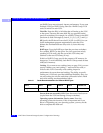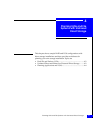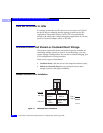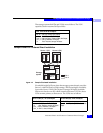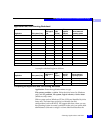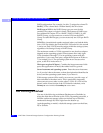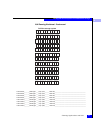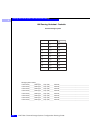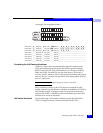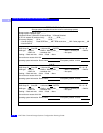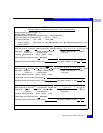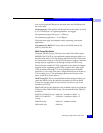
4
4-6
EMC Fibre Channel Storage Systems Configuration Planning Guide
Planning LUNs and File Systems with Unshared Direct Storage
RAID configuration. For example, for drive T, assign the volume ID
RAID5_T. The volume label will then identify the drive letter.
RAID type of LUN is the RAID Group type you want for this
partition, file system, or logical volume. The features of RAID types
are explained in Chapter 2. For a RAID 5, RAID 1, RAID 1/0, and
RAID 0 Group, you can create one or more LUNs on the RAID
Group. For other RAID types, you can create only one LUN per RAID
Group.
LUN ID is a hexadecimal number assigned when you bind the disks
into a LUN. By default, the ID of the first LUN bound is 0, the second
1, and so on. Each LUN ID must be unique within the storage system,
regardless of its Storage Group or RAID Group.
The maximum number of LUNs supported on one host-bus adapter
depends on the operating system. Some systems allow only eight
LUNs (numbers 0 through 7). For an operating system with this
restriction, if you want a hot spare, assign the hot spare an ID above
7; for example, 8 or 9. The operating system never accesses a hot
spare, so the ID is irrelevant to it.
Disk space required (Gbytes), Consider the largest amount of disk
space this application will need, then add a factor for growth.
Server hostname and operating system Enter the server hostname
(or, if you don’t know the name, a short description that identifies the
server) and the operating system name, if you know it.
If this storage system will be used by two servers, provide a copy of
this worksheet to the other server. This is particularly important
where one server may take over the other’s LUNs. If a LUN will be
shared, on the Notes section of the LUN details worksheet, write
Primary to server-name or Secondary to server-name.
LUN Planning Worksheet
Use one of the following worksheets (Rackmount or Deskside) to
select the disks that will make up the LUNs. Depending on model, a
full-fibre rackmount storage system can include up to 100 disks,
numbered 0 through 99, left to right from the bottom up.
Again depending on model, a deskside storage system can hold ten,
20, or 30 disks.



